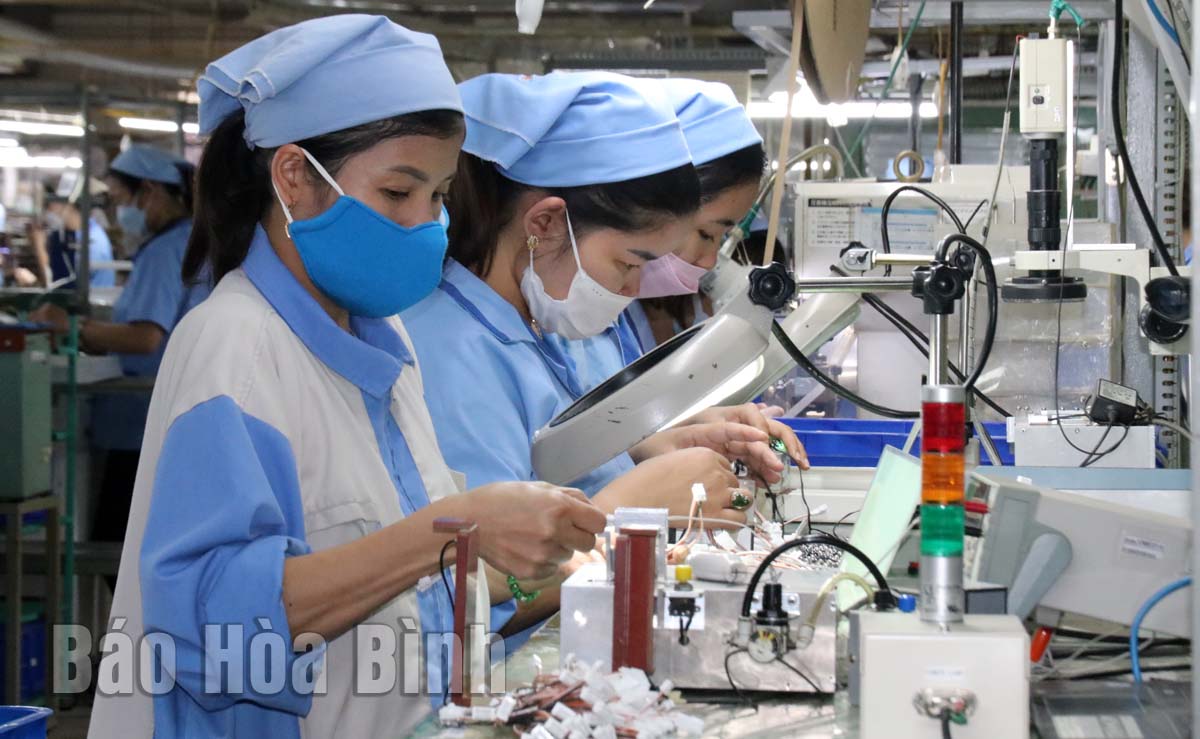
(HBO) - After the week-long 2023 Lunar New Year (Tet) holiday, almost all enterprises in Hoa Binh province have resumed their operation with a high determination to complete the set goals, contributing to the overall growth of the local economy.

Right after the Tet holiday, workers at SanKoh
Vietnam Co., Ltd at Left bank of Da River Industrial Park (Hoa Binh City)
return to work.
According to provincial authorities, as of January 30, the
majority of workers across the province had come back to their businesses and
factories. Many businesses offered transportation services for workers. Some in
Hoa Binh city and Luong Son district are in need of recruiting more experienced
and skilled workers.
To retain workers, over the past years, businesses in the province
have raised their salary, bonuses and allowances, improved working environment,
offered support in terms of train and car tickets for workers, and given lucky
money to them on the Tet occasion.
In 2022, thanks to efforts of the business community, the
province’s gross regional domestic product (GRDP) grew 9.03% to more than 32.68
trillion VND (1.39 billion USD).
The province attracted 75 domestic investment projects with
a total registered capital of about 35 trillion VND, 31 projects more than that
of the previous year.
In 2023, Hoa Binh will continue to create favourable
conditions to attract more investment and make more preferential policies to
facilitate businesses’ development, contributing to socio-economic growth as
well as ensuring social security. The province is striving for an economic
growth rate of 9%, and per capita GRDP of 70.9 million VND per year, state
budget revenue of 7.28 trillion VND, and labour productivity of 116.9 million
VND per worker.
To achieve the set economic goals, the province will
continue restructuring the economy, renewing the growth model, increasing
productivity, creating a driving force for rapid and sustainable economic
growth, improving the business and investment environment, supporting
enterprises, and attracting investment. Attention will also be paid to
promoting the development of socio-economic infrastructure and creating changes
in the industrial sector, and to key projects to promote economic restructuring
and growth model innovation./.
According to data from the Hoa Binh Provincial Party Committee, the industrial production index for the first six months of 2025 is estimated to have increased by 20% compared to the same period last year. This marks the highest year-on-year growth rate for this period since 2020.
In the first six months of 2025, Hoa Binh province’s export turnover was estimated at 1.145 billion USD, marking an 18.11% increase compared to the same period in 2024. Import turnover was estimated at $ 804 million, a 17.15% increase, which helped the province maintain a positive trade balance.
The lives of the ethnic minority farmers in Tan Lac district have gradually improved thanks to the new directions in agricultural production. This is a testament to the collective strength fostered through the professional associations and groups implemented by various levels of the district’s Farmers’ Union.
With the motto the "product quality comes first,” after nearly one year of establishment and operation, Muong village’s Clean Food Agricultural and Commercial Cooperative, located in Cau Hamlet, Hung Son Commune (Kim Boi district), has launched reputable, high-quality agricultural products to the market that are well-received by consumers. The products such as Muong village’s pork sausage, salt-cured chicken, and salt-cured pork hocks have gradually carved out a place in the market and they are on the path to obtaining the OCOP certification.
In the past, the phrase "bumper harvest, rock-bottom prices" was a familiar refrain for Vietnamese farmers engaged in fragmented, small-scale agriculture. But today, a new spirit is emerging across rural areas of Hoa Binh province - one of collaboration, organisation, and collective economic models that provide a stable foundation for production.
Maintaining growing area codes and packing facility codes in accordance with regulations is a mandatory requirement for agricultural products to be eligible for export. Recently, the Department of Agriculture and Environment of Hoa Binh province has intensified technical supervision of designated farming areas and packing facilities to safeguard the "green passport" that enables its products to access international markets.



